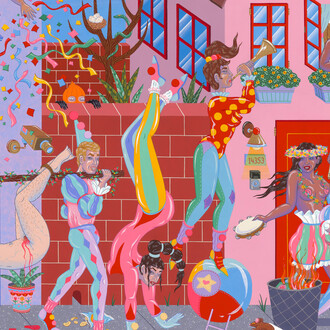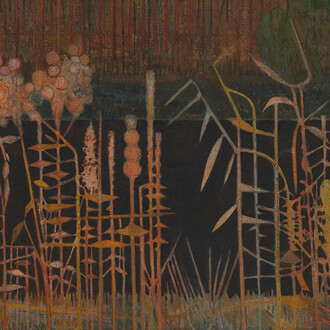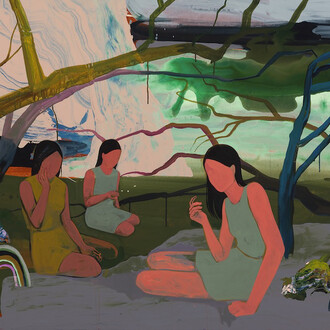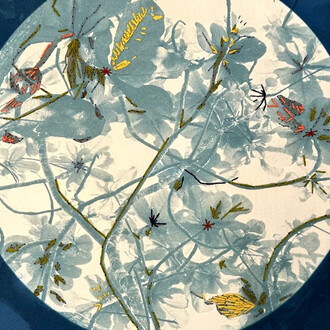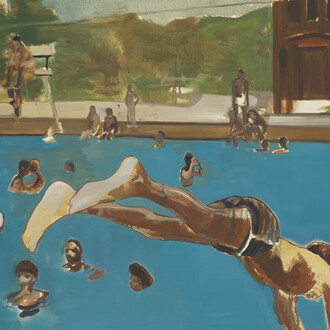…for wander is a verb that needs no object…My aim is to limit myself to the ingenuity of innate action, to be awed by it, and not to try and clear up its mysteries.
(Fernand Deligny, The arachnean and other texts, 2015, pp. 37/46)
Regen Projects is pleased to present magnetic instinct, artist Liz Larner’s ninth solo exhibition with the gallery and an official collaboration with the Getty’s PST ART: Art and Science Collide. The exhibition presents new ceramic works surrounding Larner’s Rubber Divider, 1989—two sheets of pure gum rubber connected to steel rods attached to two flame-cut, solid steel blocks that hold the tension of the opposing pull of weight and elasticity of the rubber sheets. Their opposition and mutual dependence underscores Larner’s longstanding interest in the relationship between structural support and the attitude of the object. As part of the VIP opening weekend for PST ART: Art and Science Collide, Larner will join Jonathan Griffin in conversation at 11 am on Saturday, September 14 at Regen Projects.
Engaged with the many possibilities of sculpture and abstract form, Larner uses material to encourage discoveries led by an intrinsic link between impulse and perception. Polished to a mirror finish, the brass and aluminum of these sculptures allows them to be positioned on the wall, as the side of the glazed ceramic facing the wall is reflected in the cool light of aluminum and the warm glow of brass. Each surface has its own quality, from the extremely reflective to a textured matte, and these differences create a varying vibrancy of reflected light. Larner’s ceramics highlight a symbiotic continuity that troubles definitions of art and environment, object and subject.
Larner’s morphological research thinks likewise with ecological networks, as described in the writings of Fernand Deligny, or by the botanist Anne Pringle, in Establishing new worlds: the lichens of Petersham. The dialogue between these new works and Larner’s more historic sculpture, Rubber Divider—which debuted in the 1989 Whitney Biennial—underscores the interplay between support, form, surface effect, and infrastructure, that has often animated her practice, exploring how our observed experience of the world is innately personal but based on connection. Mindful of the specter of the Anthropocene, it also occasions a meditation on how we distinguish past and present, wondering what forms, what artifacts of human action and intelligence will last, and outlast us.
Distinguished by the unique physical rules that govern its transition, from soft to fragile to almost indestructible, Larner engages clay in part because of its apparent self-determination and pliancy, a kind of material agency and chemical intelligence distinct from our own. The ceramic forms in this exhibition are molded by impressions with ubiquitous forms made with a precision that often goes unnoticed. These forms are softened by the contact of the clay being shaped by them. The consequence of this method of forming is ghostly and transpositional. Among many other potential interpretations and resonances, the exhibition’s title points to these principles, and likens them to the same encodings that inform human perception and the activity of many other life-forms, as we are learning to be of and with.
Works by Larner will concurrently be on view as part of Transformative currents: art and action in the Pacific ocean at the Orange County Museum of Art and For dear life: art, medicine, and disability at the Museum of Contemporary Art San Diego—both of which are also presented as part of PST ART: Art and Science Collide. Work by the artist is currently featured in Transmissions: selections from the Marciano Collection at the Marciano Art Foundation.
Liz Larner (b. 1960, Sacramento, CA) lives and works in Bellingham, Washington. She holds a BFA from the California Institute of the Arts.
Working across an ambitious array of materials—including plastic, bronze, fiberglass, paper, ceramic, aluminum, steel, rubber, epoxy, mirror, textiles, and even bacteria—Larner has reimagined the possibilities of sculpture over the course of her thirty-year career. Feminist in her approach to often abstract and curious forms, Larner draws from the refined and experimental vocabulary of Minimal and Postminimal precedents to occasion fresh angles for this century on questions of gender, the body, and the sustainability of life as we know it. By design, Larner’s itinerary defies simple summary and rewards persistent reflection.
Larner’s key role in the development of contemporary art has been recognized by numerous exhibitions, including two major presentations in 2022: Don’t put it back like it was, curated by Mary Ceruti for SculptureCenter, Long Island City, and Walker Art Center, Minneapolis, and below above at Kunsthalle Zürich. Past solo and two-person museum exhibitions include Liz Larner, Aspen Art Museum (2016); Liz Larner, Art Institute of Chicago (2015); Two or three or something: Maria Lassnig, Liz Larner, Kunsthaus Graz (2006); Liz Larner, Museum of Contemporary Art, Los Angeles (2001–2002); Liz Larner: I thought I saw a pussycat, MAK – Museum of Applied Arts, Vienna (1998); and Liz Larner, Kunsthalle Basel (1997).
Major public artworks by Larner have been commissioned for sites including the plaza of the Byron G. Rogers Federal Building and U.S. Courthouse, Denver (2015); University of California, San Francisco Mission Bay Project (2003); and the Riverside Pedestrian Bridge at The Walt Disney Studios, Burbank (2000).
Larner has received numerous awards, including the Mutina This Is Not a Prize (2018); The Nancy Graves Grant for Visual Artists (2014); Smithsonian American Art Museum Lucelia Artist Award (2002); the Anonymous Was a Woman grant (2000); and a Guggenheim Fellowship (1999).
Work by Larner is held in prominent international collections, including The Art Institute of Chicago; Dallas Museum of Art; Hammer Museum, Los Angeles; Hirshhorn Museum and Sculpture Garden, Washington, DC; Kunsthaus Zürich; Museo Jumex, Mexico City; Los Angeles County Museum of Art; MAK – Museum of Applied Arts, Vienna; Milwaukee Art Museum; Museum of Contemporary Art Chicago; Museum of Contemporary Art, Los Angeles; Museum of Contemporary Art San Diego; San Francisco Museum of Modern Art; Smithsonian American Art Museum, Washington, D.C.; Stedelijk Museum Amsterdam; Walker Art Center, Minneapolis; and Whitney Museum of American Art, New York; among others.










